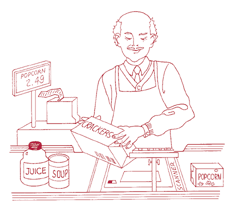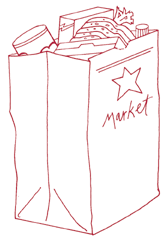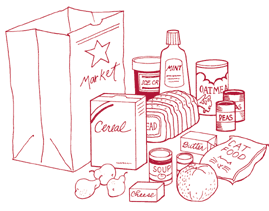|
Math at the Grocery Store
 Check It Out
Check It Out (Grades 2-3)
What you'll need: Money
- Have your child estimate the total price of items in a shopping cart. An easy way to estimate totals is to assign an average price to each item. If you have 10 items and the average price for each item is $2, the total price estimate would be about $20.
- Using the estimated total, ask your child: If I have 10 onedollar bills, how many ones will I have to give the clerk? If I have a 20-dollar bill, how much change should I receive? If I get coins back, what coins will I get?
- At the checkout counter, what is the actual cost? How does this compare to your estimate? When you pay for the items, will you get change back?
- Count the change with your child to make sure the change is correct.
Parent Pointer - Help your child use mental math by estimating cost. Then have your child participate in the checkout process where the total is added up, money is exchanged, and change is returned. |
 It's in the Bag
It's in the Bag (Grades K-4)
What to do:
- After getting home from grocery shopping, have your child guess how many objects there are in a bag. Ask: Is it full? Could it hold more? Could it tear if you put more in it? Are there more things in another bag of the same size? Why do some bags hold more or less than others?
- Put several 1-pound items in a bag. Let your child pick it up. Estimate the weight and then count the items. Was your estimate close or not?
- Estimate the weight of the bag of groceries. Does it weigh 5 pounds, 10 pounds, or more? How can you check your estimate? Now, compare one bag to another. Which is lighter or heavier? Why?
Parent Pointer - Explore ways to estimate volume and weight by looking in the bag and feeling how much it weighs. Compare it to a known weight (such as a 5-pound bag of sugar). |
 Put It Away
Put It Away (Grades 3-5)
What you'll need:
Paper, pencil, ruler, and computer
- After getting home from grocery shopping, find one characteristic that is the same for some of the products. For example, some are boxes and some are cans.
- Put together all the items that have the same characteristic.
- Find another way to group these items.
- Continue sorting, finding as many different ways to group the items as you can.
- Play "Guess My Rule." In this game, you sort the items and ask your child to guess your rule for sorting them. Then, reverse roles and let your child sort the items so that you can guess their rule.
- Using paper, pencil, ruler, and computer, make a chart of how many items are in each category.
Parent Pointer - Putting away groceries helps children develop classifying and reasoning skills and the ability to examine data or information. |
Math Activities for Grades K-5:
|
|
|